Smallholders’ Livelihood Resilience in the Dryland Area of the Yellow River Basin in China from the Perspective of the Family Life Cycle: Based on GeoDetector and LMG Metric Model
Abstract
:1. Introduction
- (1)
- Livelihood is identified as a way of making a living that individuals, families or groups depend on [8], which is composed of capabilities, assets and activities [2], focusing on the connection between assets owned by people and livelihood decisions, except for income [15]. Due to the vulnerability of their living environment, the livelihoods of highly poor and disadvantaged groups are hampered, which leads them to be unable to escape the development dilemma. The sustainable livelihood approach is a powerful livelihood tool, which takes livelihood capitals as the core and underscores transforming livelihood capitals and activities into livelihood outcomes. This method is expected to find the entry point to formulate future development strategies to strengthen the development capacity of these vulnerable groups and help them gradually remove livelihood obstacles to achieve livelihood sustainability [15]. The notion of livelihood resilience, proposed as a component of sustainable livelihoods [2], inherits the research paradigm of resilience to social-ecological systems and highlights the role of human agency and our individual and collective capacity to cope with stressors [13]. For example, people can use social networks to solve the issues of information asymmetry and resource shortages and improve the ability to cope with disasters. Resilience is an inherent attribute of a system based on the adaptive cycle theory of social-ecological systems [16]; thus, study on livelihood resilience is a further improvement of the study on livelihood system mechanisms. Livelihood resilience places people at the center to solve livelihood development needs and the limitations of livelihood activities of the poorest and most vulnerable groups with the resilience theory and provides opportunities for them to achieve sustainable livelihoods. In terms of the concept of livelihood resilience, some scholars proposed the concept of livelihood resilience by combining the concepts of livelihood and resilience, but there no consensus has been reached. The current concept that is widely applied was proposed by Tanner et al. [13], which emphasizes the capacity of all generations to maintain and improve livelihood opportunities and human well-being in the face of external disturbances.
- (2)
- Livelihood resilience assessment is the primary task for managers to understand people’s ability to cope with disturbance and formulate resilient management strategies. At present, the comprehensive evaluation method through the analysis framework is more popular. Therefore, it becomes important to build an appropriate analysis framework. Several researchers have put forward a variety of analytical frameworks according to their own research needs, but there is still no universal analytical framework. Currently, the popular analytical frameworks are the framework of buffering, self-organization and learning capacity proposed by Speranza et al. [17] and the resilience index measurement approach (RIMA), proposed by the Food and Agriculture Organization [18], respectively. In addition, Sina et al. [8] developed a measuring livelihood resilience framework, comprising individual livelihood coping capacity, individual well-being, access to livelihood resources and social-physical robustness of local community, applying thematic analysis based on a literature review. Bahadur et al. [14] developed a 3As (adaptive capacity, anticipatory capacity and absorptive capacity) framework in the project “Building resilience and adaptation to climate extremes and disasters project”, funded by the Department for International Development (DFID), which constructed a comprehensive indicator system at household and community levels. The assessment facilitates the integration of livelihood and resilience, as well as issues related to human agency and empowerment, which is in line with the notion of livelihood resilience proposed by Tanner et al. [13]. Because of this, this study used this framework to assess the livelihood resilience of smallholders.
- (3)
- Identifying the key factors of livelihood resilience can help managers to integrate existing resources and formulate effective livelihood resilience improvement policies for vulnerable groups. Some scholars have attempted to explore the influencing factors of livelihood resilience. For instance, Ado et al. [21] studied influencing factors of farmers’ resilience to food security in the Aguie district of Niger and showed that family size, agricultural production and agricultural experience were the most important determinants of farmers’ resilience to food security. Li et al. [22] revealed that education investment, social network, family burden ratio, and family size were the major factors that influenced the livelihood resilience of relocated migrants in China. Wen et al. [23] revealed that savings, per capita income, educational investment, educational level of household head, as well as social networks, were the core factors that influenced the resilience of households on the Loess Plateau in China. These pieces of literature have directly or indirectly confirmed the significant impacts of household characteristics and related factors on livelihood resilience, which are closely related to the family life cycle. The concept of family life cycle (FLC) was first proposed by Rowntree [24], which refers to the process of birth, development and disappearance of a family [25]. At present, the impact of FLC on smallholders has attracted the extensive attention of scholars. The existing literature mainly focused on the relationships between FLC and farmland management scale [26,27,28], smallholders’ farmland transfer behaviors [29], livelihood strategy [29,30], rural labor transfer [31], and multidimensional poverty [32,33]. They explicitly or implicitly reflected that there were differences in capital accumulation, family size, dependency burden, livelihood risks and livelihood strategies of a household as the evolution of FLC [28,34], which lead to different livelihood resilience levels. However, there are few related studies. Therefore, this study attempts to explore the influencing factors of smallholders’ livelihood resilience from the perspective of the FLC, which helps stakeholders to understand the research mechanism of livelihood resilience, and provide references for local governments and managers to formulate targeted resilient livelihood measures.
2. Materials and Methods
2.1. Study Area
2.2. Data Collection
2.3. Theoretical Framework
2.4. Methods
2.4.1. Livelihood Resilience Measurement
- ①
- Building a dimensionless data matrix
- ②
- Computing the weight normalization matrix
- ③
- Computing the positive ideal solution and negative ideal solution
- ④
- Computing the Euclidean distance between each identified indicator and positive and negative ideal solutions
- ⑤
- Computing the close-degree of the positive and negative ideal solutions and the surveyed respondentswhere the values of are between 0 and 1. with a high value indicates that the evaluated objective is larger.
- ⑥
- Computing the livelihood resilience LRwhere , and represent the adaptive capacity, absorptive capacity and anticipatory capacity of the i-th sample, respectively.
2.4.2. The Specification of the GeoDetector Model
2.4.3. The Specification of the LMG Metric Model
- ①
- Firstly, a multiple linear regression model (MLR) is established to calculate R2, shown by the following equation:where Model SS represents the sum of squares of the model, and Total SS is the total sum of squares.
- ②
- When adding the regressors in a set M to a model, the additional R2 is defined as seq R2, which is calculated by the following formula:
- ③
- The formula for R2 allocated to the regressor in the order r can be written as follows:where denotes a set of regressors entered into the model before regressors in the order r. The order of the regressors in any model is a permutation of the available regressors , which is expressed by the tuple of indicators
- ④
- The metric LMG for the regressors is calculated as follows:
3. Results
3.1. Description of Livelihood Resilience
3.1.1. Adaptive, Anticipatory and Absorptive Capacity
3.1.2. Livelihood Resilience
3.2. Influencing Factors of Livelihood Resilience
3.2.1. The Results of Factor Detection
3.2.2. LMG Metric
3.3. Bivariate Correlations
4. Discussion
4.1. Livelihood Resilience of Smallholders in Different Stages of the FLC
4.2. Analyzing the Influencing Factors of Livelihood Resilience
4.3. Comparative Analysis
5. Conclusions
- (1)
- There were significant differences in the livelihood resilience, adaptive capacity and anticipatory capacity of smallholders in each stage of the FLC at a 5% level. Livelihood resilience in the burdening stage and the empty-nest stage was lower than the population mean value, while the resilience of livelihood in the initial stage, raising stage, stable stage and supported stage was higher than or equal to the population mean value.
- (2)
- Preparedness and planning and substitutable assets resources had the impacts on the livelihood resilience of smallholders at each stage of the FLC. And the factor of family characteristics also was an important determinant. Furthermore, the impact of family assets and access to basic services on the smallholders’ livelihood resilience showed a U-shaped trend with the evolution of the FLC. On the contrary, the impact of savings and safety net on livelihood resilience presented an inverted U-shaped trend with the evolution of the FLC.
- (3)
- Comparing the results of the GeoDetector and LMG metric models, it was found that the two models can better explore the key influencing factors of livelihood resilience, such as family characteristics, preparedness and income, and substitutable asset resources. However, there were differences in the relative importance rankings of the given regressors in each stage of the FLC between the two models, especially in the raising stage and supported stage. Through comparison and analysis, we found that the results obtained by the GeoDetector were more accurate to explore the relative importance of indicators to livelihood resilience in this study.
Author Contributions
Funding
Institutional Review Board Statement
Informed Consent Statement
Data Availability Statement
Acknowledgments
Conflicts of Interest
Research Involving Human Subjects
References
- Zhang, H.; Li, X. Discussion on the livelihood framework design of return fishmen from the perspective of sustainable livelihood theory. Chin. Fish. Econ. 2022, 40, 102–110. [Google Scholar]
- Scoones, I. Sustainable Rural Livelihoods: A Framework for Analysis; Institute of Development Studies: Brighton, UK, 1998; Available online: https://www.staff.ncl.ac.uk/david.harvey/AEF806/Sconnes1998.pdf (accessed on 24 October 2021).
- Davies, S. Adaptable Livelihoods: Coping with Food Insecurity in the Malian Sahel; Macmillan: London, UK, 1996. [Google Scholar]
- Cutter, S.L.; Ahearn, J.A.; Amadei, B.; Crawford, P.; Zoback, M.L. Disaster resilience: A national imperative. Environ. Sci. Policy Sustain. Dev. 2012, 55, 25–29. [Google Scholar] [CrossRef]
- Qin, H.; Liu, T.; Huang, Y. Evaluation and Sensitivity Analysis of Forest Ecosystem Resilience at Provincial Scale in China. J. Ecol. Rural Environ. 2022, 38, 281–288. [Google Scholar]
- Berkes, F.; Colding, J.; Folke, C. Navigating Social-Ecological Systems: Building Resilience for Complexity and Change; Cambridge University Press: Cambridge, UK, 2003. [Google Scholar]
- Cai, J.L.; Kummu, M.; Niva, V.; Guillaume, J.H.A.; Varis, O. Exposure and resilience of China’s cities to floods and droughts: A double-edged sword. Int. J. Water Resour. D 2018, 34, 547–565. [Google Scholar] [CrossRef]
- Sina, D.; Chang-Richards, A.Y.; Wilkinson, S.; Potangaroa, R. A conceptual framework for measuring livelihood resilience: Relocation experience from Aceh, Indonesia. World Dev. 2019, 117, 253–265. [Google Scholar] [CrossRef]
- Walker, B.; Salt, D. Resilience Thinking. Sustaining Ecosystems and People in a Changing World; Island Press: Washington, DC, USA, 2006. [Google Scholar]
- Scoones, I. Livelihoods perspectives and rural development. J. Peasant Stud. 2009, 36, 171–196. [Google Scholar] [CrossRef]
- Marschke, M.J.; Berkes, F. Exploring strategies that build livelihood resilience: A case from Cambodia. Ecol. Soc. 2006, 11, 42. [Google Scholar] [CrossRef]
- Holling, C.S. Resilience and stability of ecological systems. Annu. Rev. Ecol. Syst. 1973, 4, 1–23. [Google Scholar] [CrossRef]
- Tanner, T.; Lewis, D.; Wrathall, D.; Bronen, R.; Cradock-Henry, N.; Huq, S.; Lawless, C.; Nawrotzki, R.; Prasad, V.; Rahman, M.A.; et al. Livelihood resilience in the face of climate change. Nat. Clim. Chang. 2015, 5, 23–26. [Google Scholar] [CrossRef]
- Bahadur, A.; Peters, K.; Wilkinson, E.; Pichon, F.; Gray, K.; Tammer, T. The 3As: Tracking Resilience across BRACED; Overseas Development Institute: London, UK, 2015; Available online: https://www.researchgate.net/publication/281411203 (accessed on 21 October 2021).
- Su, F.; Xu, Z.; Shang, H. An overview of sustainable livelihoods approach. Adv. Earth Sci. 2009, 24, 61–69. [Google Scholar]
- Song, S.; Wang, S.; Fu, B.; Chen, H.; Liu, Y.; Zhao, W. Study on adaptive governance of social-ecological system: Progress and prospect. Acta Geographica Sinica 2019, 74, 2401–2410. [Google Scholar]
- Speranza, C.I.; Wiesmann, U.; Rist, S. An indicator framework for assessing livelihood resilience in the context of social-ecological dynamics. Glob. Environ. Chang. 2014, 28, 109–119. [Google Scholar] [CrossRef]
- Food and Agriculture Organization (FAO). Measuring Resilience: A Concept Note on the Resilience Tool. 2010. Available online: http://www.fao.org/3/al920e/al920e00.pdf (accessed on 15 October 2021).
- Tang, Q. Research progress and future key trends of sustainable livelihoods. Adv. Earth Sci. 2015, 30, 823–833. [Google Scholar]
- Li, T.; Liu, B.; Tan, S. A review of livelihood resilience research and its analytical framework. China Price 2018, 2, 35–37. [Google Scholar]
- Ado, A.M.; Savadogo, P.; Abdoul-Azize, H.T. Livelihood strategies and household resilience to food insecurity: Insight from a farming community in Aguie district of Niger. Agr. Hum. Values 2019, 36, 747–761. [Google Scholar] [CrossRef]
- Li, C.; Wang, L.; Kang, B.; Gao, M. Measurement and influencing factors of livelihood resilience of relocated migrants. J. Xi’an Jiaotong Univ. 2019, 39, 38–47. [Google Scholar]
- Wen, T.; Shi, Y.; Yang, X.; Wang, T. The resilience of farmers’ livelihoods and its influencing factors in semiarid region of the Loess Plateau: A case study of Yuzhong county. Chin. J. Agric. Resour. Reg. Plan. 2018, 39, 172–182. [Google Scholar]
- Rowntree, B.S.; Hunter, R. Poverty: A study of town life. Charity Organ. Rev. 1902, 11, 260–266. [Google Scholar]
- Shi, Q.; Hou, R. Study on household life cycle and its economic operation. Res. Agric. Mod. 2001, 2, 65–70. [Google Scholar]
- Liang, L.; Lin, S.; Zhang, Z. Effect of the family life cycle on the family farm scale in Southern China. Agric. Econ. 2015, 61, 429–440. [Google Scholar] [CrossRef] [Green Version]
- Zhu, P.; Yang, Z.; Rao, F. The effect of family life cycle on land-scale management. Chin. J. Popul. Sci. 2017, 6, 43–53. [Google Scholar]
- Zhao, W.; Zhang, N. Arable land operation scale, family life cycle and rural households’ livelihood strategies. China Popul. Resour. Environ. 2019, 29, 157–164. [Google Scholar]
- Ye, Z.; Cai, J.; Chen, Y.; Xia, X. Study on the effect of family life cycle on farmers’ farmland transfer behavior: An empirical analysis based on survey data of farmers in Qinba mountain area. Resour. Environ. Yangtze Basin 2019, 28, 1929–1937. [Google Scholar]
- Xu, D.; Ma, Z.; Deng, X.; Liu, Y.; Huang, K.; Zhou, W.; Yong, Z. Relationships between land management scale and livelihood strategy selection of rural households in China from the perspective of family life cycle. Land 2020, 9, 11. [Google Scholar] [CrossRef]
- Wang, W.; Wu, H. The determinants of rural labor transfer to non-agricultural sectors from the perspective of family life cycle: An analysis using field survey data in Hubei Province. China Rural. Surv. 2017, 6, 57–70. [Google Scholar]
- Ma, Z. Social capital, family life cycle and farmers’ multidimensional poverty. Stat. Decis. 2021, 37, 5–9. [Google Scholar]
- Peng, J.; Wu, H.; Meng, Q. Study on family life cycle, social capital and rural households’ livelihood strategy. J. China Agric. Univ. 2018, 23, 196–217. [Google Scholar]
- Yang, S.; Yu, J. The impact of risk on poverty from the perspective of family life cycle: A case of poverty-stricken areas in Qinba mountains. J. Arid Land Resour. Environ. 2020, 34, 59–65. [Google Scholar]
- Nasr, J.B.; Chaar, H.; Bouchiba, F.; Zaibet, L. Assessing and building climate change resilience of farming systems in Tunisian semi-arid areas. Environ. Sci. Pollut. Res. 2021, 28, 46797–46808. [Google Scholar] [CrossRef]
- Wang, Y.; Zhang, Q.; Li, Q.; Wang, J.; Sannigrahi, S.; Richard, B.; Bellingrath-Kimura, S.D.; Li, J.; Song, C. Role of social networks in building household livelihood resilience under payments for ecosystem services programs in a poor rural community in China. J. Rural Stud. 2021, 86, 208–225. [Google Scholar] [CrossRef]
- Wang, J.; Xu, C. Geodetector: Principle and prospective. Acta Geogr. Sin. 2017, 72, 116–134. [Google Scholar]
- Liu, M.; Hu, S.; Ge, Y.; Heuvelink, G.B.M.; Ren, Z.; Huang, X. Using multiple linear regression and random forests to identify spatial poverty determinants in rural China. Spat. Stat-Neth. 2021, 42, 100461. [Google Scholar] [CrossRef]
- Xia, L.; Liu, J.; Wei, F.; Xu, Z.; Long, X.; Zhang, Y. Spatiotemporal pattern changes of cultivated land in Weibei Dryland of Shaanxi Province. Trans. Chin. Soc. Agric. Eng. 2021, 37, 256–264. [Google Scholar]
- Song, X.; Liu, X.; Shen, B.; Shi, W. Problems of water resources and the measures for the regulation of planting structure in the Weibei rainfed highland, Shaanxi Province. Arid Land Geogr. 2004, 2, 199–201. [Google Scholar]
- Campbell, D. Environmental change and the livelihood resilience of coffee farmers in Jamaica: A case study of the Cedar Valley farming region. J. Rural Stud. 2021, 81, 220–234. [Google Scholar] [CrossRef]
- Li, Q.; Long, W. Analysis on the influencing factors of migrant workers’ intension to stay in cities and return home. Chin. Rural. Econ. 2009, 2, 46–54. [Google Scholar]
- Yao, G.; Wan, G. Family life cycle variation of migrant workers and its influence on their household consumption structure. J. Manag. World 2016, 11, 96–109. [Google Scholar]
- Lin, S.; Wang, J. Analysis of family life cycle on rural labor transfer. China Rural. Surv. 2010, 1, 25–33, 93–94. [Google Scholar]
- Kruskal, W. Correction: Relative importance by averaging over orderings. Am. Stat. 1987, 41, 6–10. [Google Scholar] [CrossRef]
- Grömping, U. Relative importance for linear regression in R: The package relaimpo. J. Stat. Softw. 2007, 17, 1–27. [Google Scholar] [CrossRef] [Green Version]
- Chang, Q.; Li, X.; Xie, X.; Zhao, M. The impact of non-agricultural employment on farmers’ ecological production behavior: Based on the mediating effect of agricultural production and operation characteristics and the regulating effect of the family life cycle. China Rural Surv. 2020, 1, 76–93. [Google Scholar]
- Fan, Y.; Shi, X.; Feng, X.; Song, Z. Livelihood vulnerability and its influencing factors of farmers in dryland area of Yellow River Basin. Atca Ecol. Sin. 2022, 42, 3134–3143. [Google Scholar]
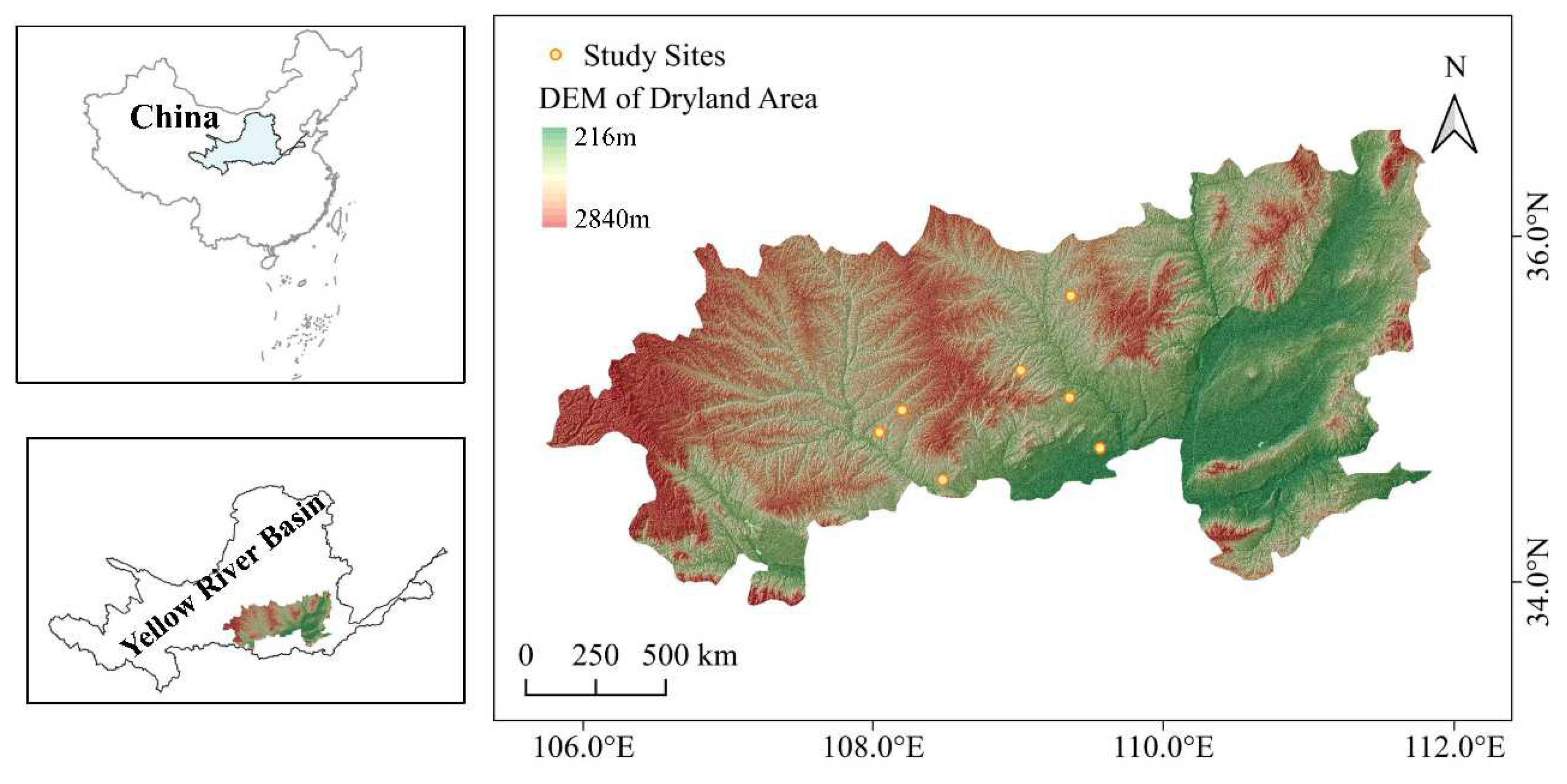
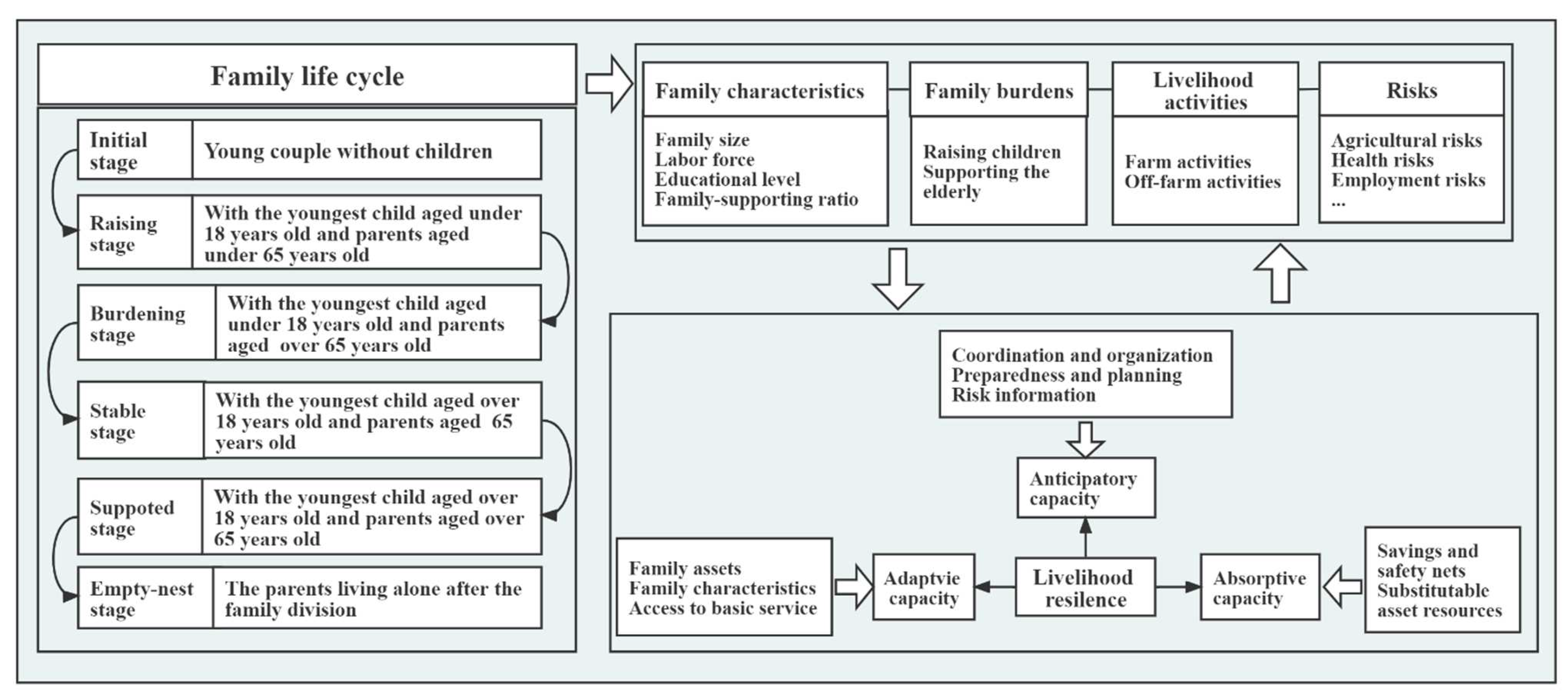
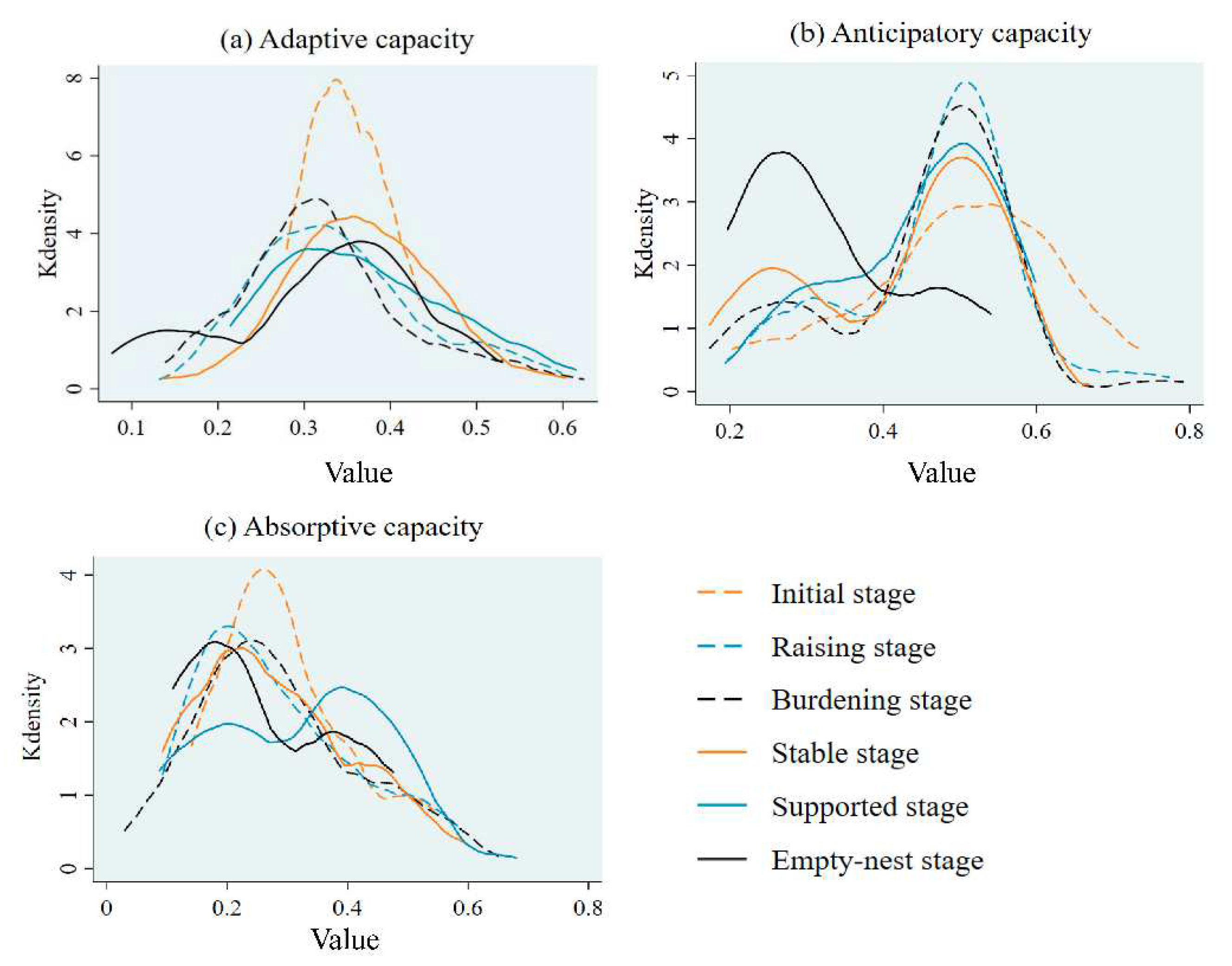
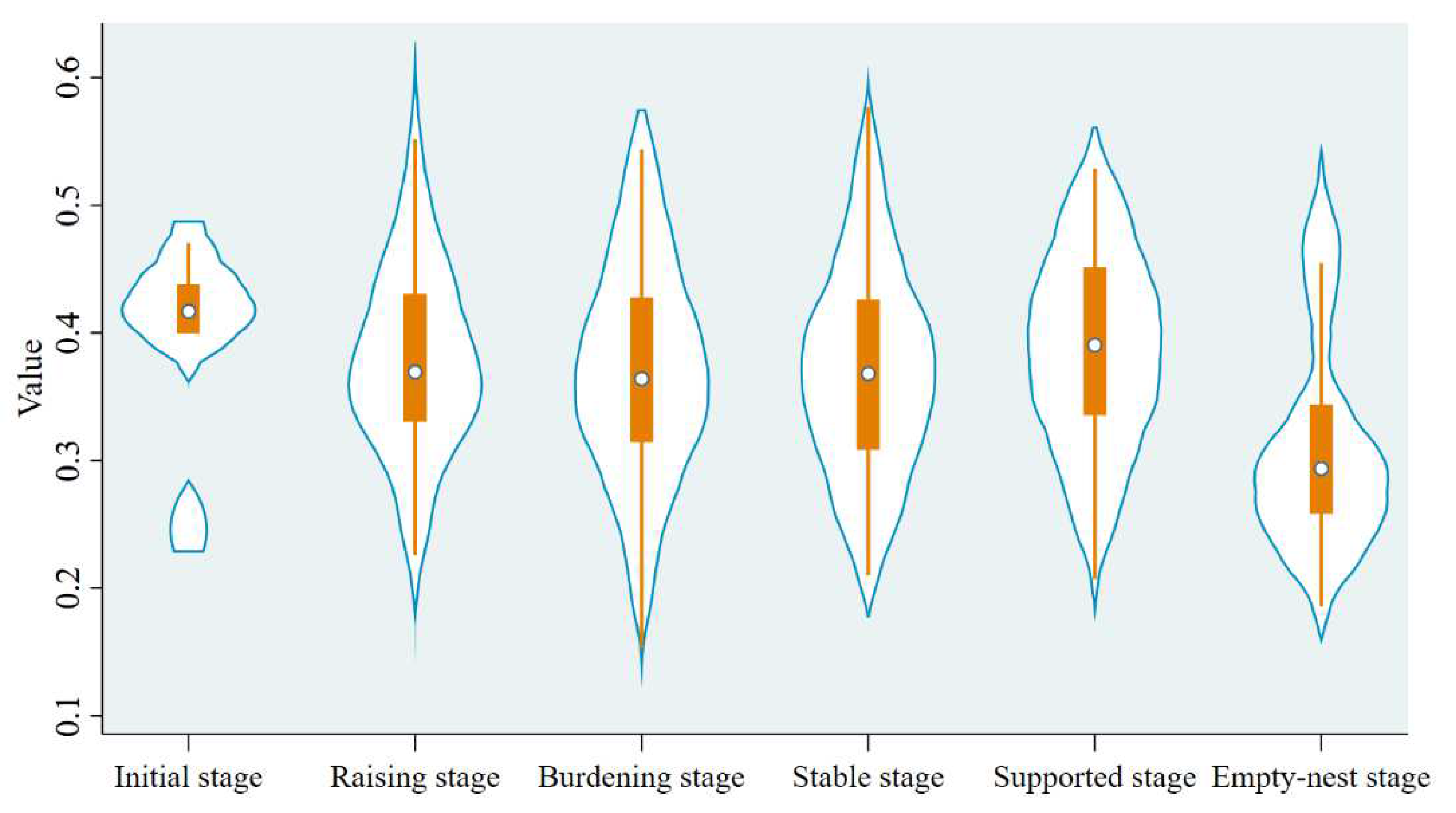
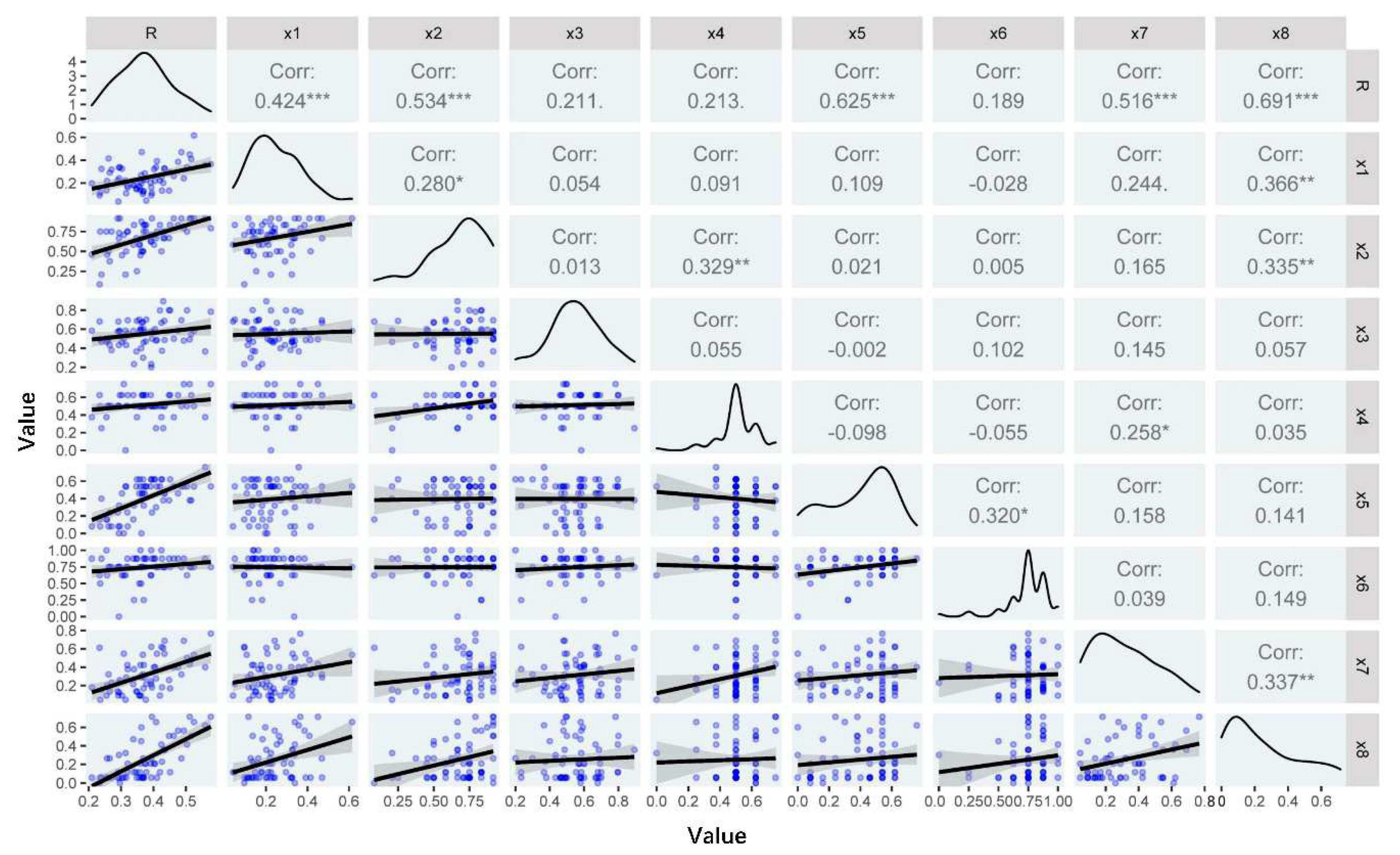
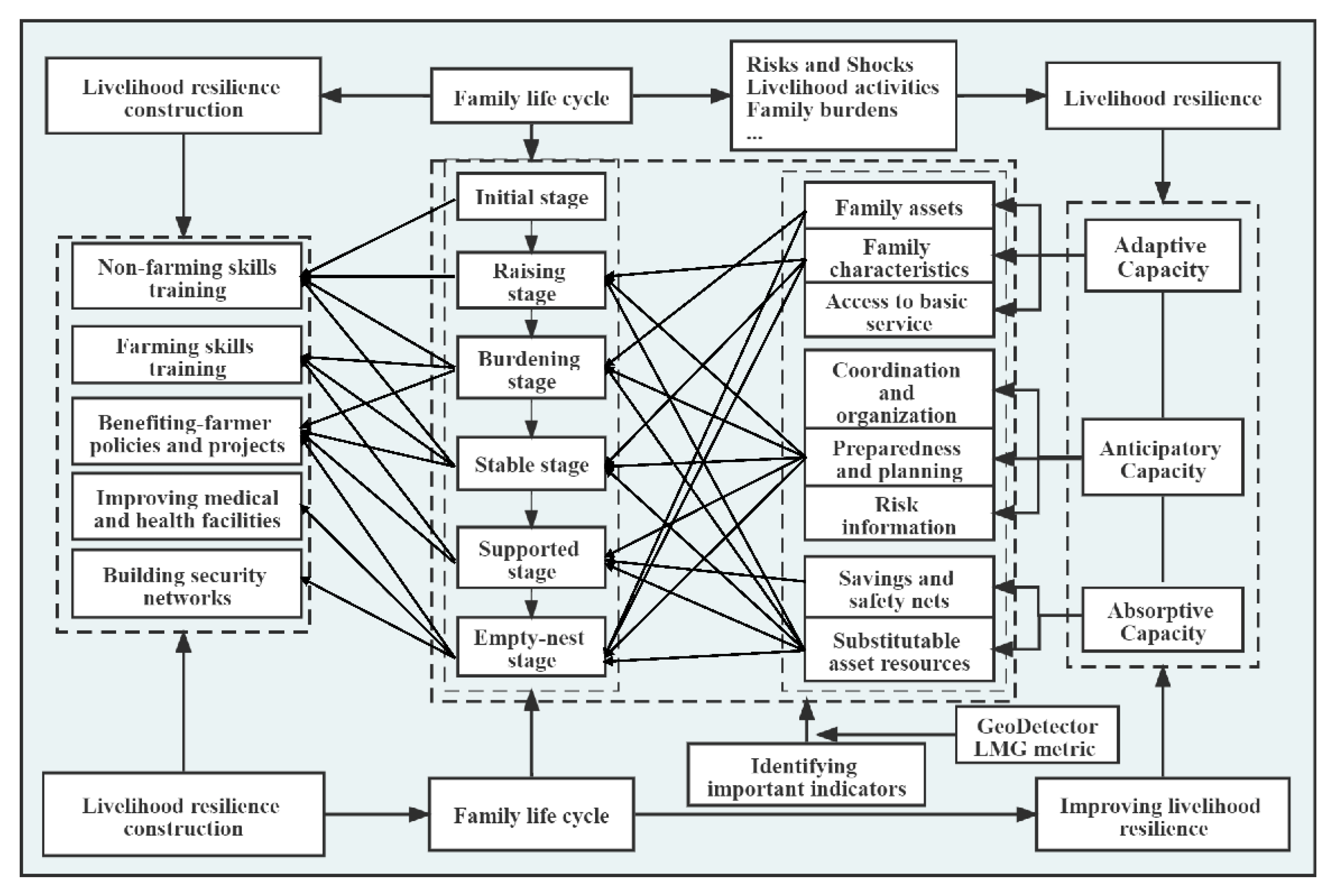
| Components | Dimensions | Indicators | Descriptions of Indicators | Roles | Weights |
|---|---|---|---|---|---|
| Adaptive capacity | Family assets X1 | Farmland areas A1 | 1 = 5 mu and below, 2 = 5~10 mu, 3 = 10~15 mu, 4= 15~20 mu, 5 = 20mu and above (1 mu is about 0.067 ha) | + | 0.120 |
| Durable goods A2 | Number of durable goods possessed by a household/piece | + | 0.060 | ||
| Housing area A3 | The total area of housing owned by a household/m2 | + | 0.120 | ||
| Family characteristics X2 | Education level A4 | The educational level of a household head, 1 = primary school and below, 2 = junior high school, 3 = senior high school, 4 = junior college, 5 = university and above | + | 0.134 | |
| Health A5 | The general health of family members, 1 = very unhealthy, 5 = very healthy | + | 0.134 | ||
| Family-supporting ratio A6 | The ratio of non-labor population to total population in a family/% | - | 0.270 | ||
| Access to basic services X3 | Traffic convenience A7 | The smallholders’ distance from the nearest market /km | - | 0.066 | |
| Medical facility A8 | Supporting facilities of hospital nearest to a family, 1 = very few, 5 = many | + | 0.066 | ||
| Irrigation water A9 | Whether farmland can be continuously irrigated, 1 = yes, 0 = no | + | 0.200 | ||
| Anticipatory capacity | Coordination and organization X4 | Skill training B1 | Whether family members participated in farm skill training, 1 = yes, 0 = no | + | 0.149 |
| Farmer-benefiting policies and projects B2 | Whether there were farmer-benefiting policies and projects, 1 = yes, 0 = no | + | 0.149 | ||
| Preparedness and planning X5 | Strategies to coping with agricultural disaster risks B3 | Number of measures adopted to deal with agricultural disaster risks (such as increasing pesticides, irrigations, plastic mulching, soil moisture conservation techniques, changing crop varieties and cropping structures) | + | 0.216 | |
| Diversity of livelihood activities B4 | Whether a family adopts off-farm measures to resist external disturbance, 1 = yes, 0 = no | + | 0.323 | ||
| Risk information X6 | Disaster risk information B5 | Number of ways to obtain disaster risk information, 1 = very few, 5 = many | + | 0.082 | |
| Weather forecast B6 | Whether you often follow the weather forecast, 1 = yes, 0 = no | + | 0.082 | ||
| Absorptive capacity | Savings and security nets X7 | Savings C1 | 1 = CNY 10,000 and below, 2 = CNY 10,000–40,000, 3 = CNY 40,000–70,000, 4= CNY 70,000–100,000, 5 = CNY 100,000 and above | + | 0.157 |
| Agricultural insurance C2 | Whether a smallholder buys agricultural insurance, 1 = yes, 0 = no | + | 0.054 | ||
| Assistance from kith and kin C3 | 1 = very little, 5 = very much | + | 0.090 | ||
| Government assistance C4 | Whether you get assistance from local government, 1 = yes, 0 = no | + | 0.032 | ||
| Credit services C5 | Whether farmers have access to credit services, 1 = yes, 0 = no | + | 0.166 | ||
| Substitutable asset resources X8 | Off-farm income C6 | Whether the family has off-farm income, 1 = yes, 0 = no | + | 0.300 | |
| Crop diversity C7 | Number of species of crops | + | 0.200 |
| Initial Stage | Raising Stage | Burdening Stage | Stable Stage | Supported Stage | Empty-Nest Stage | Mean Value | Homogeneity Variance | ANOVA | |
|---|---|---|---|---|---|---|---|---|---|
| Adaptive capacity | 0.349 | 0.341 | 0.327 | 0.368 | 0.370 | 0.318 | 0.345 | 0.069 | 0.033 ** |
| Anticipatory capacity | 0.494 | 0.465 | 0.446 | 0.417 | 0.446 | 0.329 | 0.440 | 0.262 | 0.000 *** |
| Absorptive capacity | 0.298 | 0.284 | 0.286 | 0.280 | 0.320 | 0.262 | 0.287 | 0.687 | 0.597 |
| Livelihood resilience | 0.398 | 0.380 | 0.369 | 0.372 | 0.384 | 0.320 | 0.372 | 0.789 | 0.032 ** |
| Family Assets | Family Characteristics | Access to Basic Services | Coordination and Organization | Preparedness and Planning | Risk Information | Savings and Safety Nets | Substitutable Asset Resources | |
|---|---|---|---|---|---|---|---|---|
| Raising stage | 0.134 | 0.252 | 0.094 | 0.005 | 0.388 | 0.100 | 0.092 | 0.337 |
| Burdening stage | 0.195 | 0.187 | 0.052 | 0.054 | 0.383 | 0.083 | 0.132 | 0.425 |
| Stable stage | 0.145 | 0.219 | 0.160 | 0.100 | 0.380 | 0.065 | 0.273 | 0.453 |
| Supported stage | 0.108 | 0.221 | 0.174 | 0.052 | 0.343 | 0.045 | 0.264 | 0.505 |
| Empty-nest stage | 0.423 | 0.350 | 0.237 | 0.202 | 0.435 | 0.154 | 0.223 | 0.661 |
| Family Assets | Family Characteristics | Access to Basic Services | Coordination and Organization | Preparedness and Planning | Risk Information | Savings and Safety Nets | Substitutable Asset Resources | |
|---|---|---|---|---|---|---|---|---|
| VIF | 1.145 | 1.066 | 1.052 | 1.046 | 1.078 | 1.031 | 1.110 | 1.125 |
| Family Assets | Family Characteristics | Access to Basic Services | Coordination and Organization | Preparedness and Planning | Risk Information | Savings and Safety Nets | Substitutable Asset Resources | |
|---|---|---|---|---|---|---|---|---|
| Raising stage | 0.076 | 0.134 | 0.078 | 0.004 | 0.335 | 0.003 | 0.079 | 0.291 |
| Burdening stage | 0.124 | 0.087 | 0.038 | 0.016 | 0.332 | 0.003 | 0.066 | 0.335 |
| Stable stage | 0.064 | 0.158 | 0.030 | 0.023 | 0.321 | 0.015 | 0.117 | 0.272 |
| Supported stage | 0.084 | 0.073 | 0.097 | 0.004 | 0.269 | 0.003 | 0.083 | 0.388 |
| Empty-nest stage | 0.192 | 0.141 | 0.074 | 0.012 | 0.249 | 0.054 | 0.049 | 0.229 |
Publisher’s Note: MDPI stays neutral with regard to jurisdictional claims in published maps and institutional affiliations. |
© 2022 by the authors. Licensee MDPI, Basel, Switzerland. This article is an open access article distributed under the terms and conditions of the Creative Commons Attribution (CC BY) license (https://creativecommons.org/licenses/by/4.0/).
Share and Cite
Li, X.; Shi, X. Smallholders’ Livelihood Resilience in the Dryland Area of the Yellow River Basin in China from the Perspective of the Family Life Cycle: Based on GeoDetector and LMG Metric Model. Land 2022, 11, 1427. https://doi.org/10.3390/land11091427
Li X, Shi X. Smallholders’ Livelihood Resilience in the Dryland Area of the Yellow River Basin in China from the Perspective of the Family Life Cycle: Based on GeoDetector and LMG Metric Model. Land. 2022; 11(9):1427. https://doi.org/10.3390/land11091427
Chicago/Turabian StyleLi, Xueping, and Xingmin Shi. 2022. "Smallholders’ Livelihood Resilience in the Dryland Area of the Yellow River Basin in China from the Perspective of the Family Life Cycle: Based on GeoDetector and LMG Metric Model" Land 11, no. 9: 1427. https://doi.org/10.3390/land11091427
APA StyleLi, X., & Shi, X. (2022). Smallholders’ Livelihood Resilience in the Dryland Area of the Yellow River Basin in China from the Perspective of the Family Life Cycle: Based on GeoDetector and LMG Metric Model. Land, 11(9), 1427. https://doi.org/10.3390/land11091427







